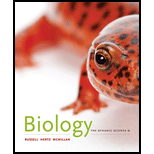
As CO2 concentrations increase in the atmosphere, biologists continue to explore the role of respiration from plants as a small but potentially important contribution beyond fossil fuel combustion. The data in the Table were collected from the leaf of a sagebrush plant from a semiarid ecosystem in Wyoming, enclosed in a chamber that measures the rate of CO2 exchange. The respiration rate is the amount of CO2 in micromoles lost by the leaf per square meter per second, which results in the negative numbers. The temperature values are from the leaves as they are heated or cooled during the measurements.
| Observation | Temperature (°C) | Respiration Rate (μmol/m2/s) |
| 1 | 25 | -2.0 |
| 2 | 30 | -2.7 |
| 3 | 35 | -4.1 |
| 4 | 40 | -5.8 |
| 5 | 20 | -1.3 |
| 6 | 15 | -1.0 |
| 7 | 10 | -0.7 |
© Cengage Learning 2017
What describes the relationship between temperature and respiration, a line or a curve? Does the Q10 that you calculated in 2 suggest a line or a curve?
Source: Data based on unpublished research by Brent Ewers, University of Wyoming.
Want to see the full answer?
Check out a sample textbook solution
Chapter 7 Solutions
Biology: The Dynamic Science (MindTap Course List)
- Plating 50 microliters of a sample diluted by a factor of 10-6 produced 91 colonies. What was the originalcell density (CFU/ml) in the sample?arrow_forwardEvery tutor here has got this wrong, don't copy off them.arrow_forwardSuppose that the population from question #1 (data is in table below) is experiencing inbreeding depression (F=.25) (and no longer experiencing natural selection). Calculate the new expected genotype frequencies (f) in this population after one round of inbreeding. Please round to 3 decimal places. Genotype Adh Adh Number of Flies 595 Adh Adh 310 Adhs Adhs 95 Total 1000 fladh Adh- flAdn Adh fAdhs Adharrow_forward
- Which of the following best describes why it is difficult to develop antiviral drugs? Explain why. A. antiviral drugs are very difficult to develop andhave no side effects B. viruses are difficult to target because they usethe host cell’s enzymes and ribosomes tometabolize and replicate C. viruses are too small to be targeted by drugs D. viral infections usually clear up on their ownwith no problemsarrow_forwardThis question has 3 parts (A, B, & C), and is under the subject of Nutrition. Thank you!arrow_forwardThey got this question wrong the 2 previous times I uploaded it here, please make sure it's correvct this time.arrow_forward
- This question has multiple parts (A, B & C), and under the subject of Nutrition. Thank you!arrow_forwardCalculate the CFU/ml of a urine sample if 138 E. coli colonies were counted on a Nutrient Agar Plate when0.5 mls were plated on the NA plate from a 10-9 dilution tube. You must highlight and express your answerin scientific notatioarrow_forwardDon't copy off the other answer if there is anyarrow_forward
 Biology: The Dynamic Science (MindTap Course List)BiologyISBN:9781305389892Author:Peter J. Russell, Paul E. Hertz, Beverly McMillanPublisher:Cengage Learning
Biology: The Dynamic Science (MindTap Course List)BiologyISBN:9781305389892Author:Peter J. Russell, Paul E. Hertz, Beverly McMillanPublisher:Cengage Learning
 Biology 2eBiologyISBN:9781947172517Author:Matthew Douglas, Jung Choi, Mary Ann ClarkPublisher:OpenStax
Biology 2eBiologyISBN:9781947172517Author:Matthew Douglas, Jung Choi, Mary Ann ClarkPublisher:OpenStax BiochemistryBiochemistryISBN:9781305577206Author:Reginald H. Garrett, Charles M. GrishamPublisher:Cengage LearningCase Studies In Health Information ManagementBiologyISBN:9781337676908Author:SCHNERINGPublisher:Cengage
BiochemistryBiochemistryISBN:9781305577206Author:Reginald H. Garrett, Charles M. GrishamPublisher:Cengage LearningCase Studies In Health Information ManagementBiologyISBN:9781337676908Author:SCHNERINGPublisher:Cengage





